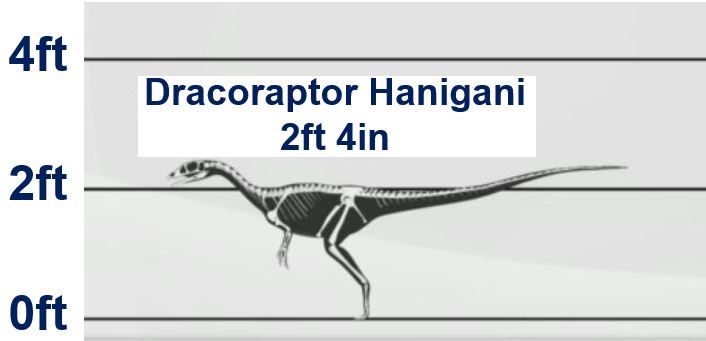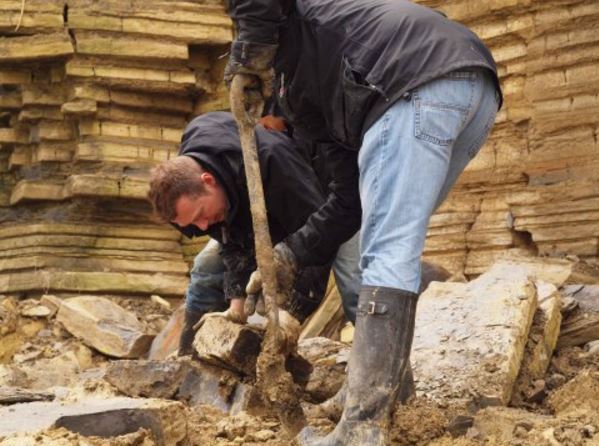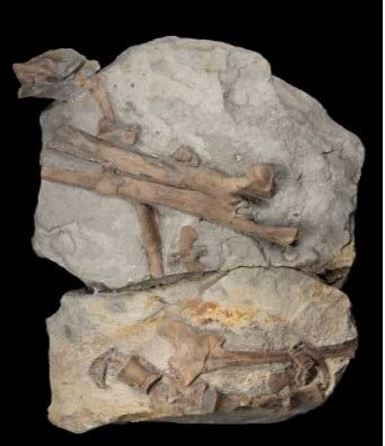The Welsh Dragon Thief Dinosaur (Dracoraptor hanigani) existed more than 200 million years ago and was a distant cousin of T rex (Tyrannosaurus rex). The skeletal fossil of this carnivorous dinosaur was uncovered by spring storms in 2014 and found by hunting brothers Rob and Nick Hanigan following a cliff fall.
One year later, Sam Davies, who is studying palaeontology at the University of Portsmouth, came across a fossilised foot during a field trip, at exactly the same location – a beach near Penarth in the Vale of Glamorgan in south Wales.
A group of palaeontologists from the University of Portsmouth, the University of Manchester, and the National Museum Wales, wrote about their find in the scientific journal PLOS ONE.
 The Dragon Thief (Dracoraptor hanigani) and Tyrannosaurus rex are distant cousins.(Adapted from Image: port.ac.uk. Credit: National Museum Wales)
The Dragon Thief (Dracoraptor hanigani) and Tyrannosaurus rex are distant cousins.(Adapted from Image: port.ac.uk. Credit: National Museum Wales)
Dr. David M. Martill, from the School of Earth and Environmental Sciences at the University of Portsmouth, and colleagues believe Dacoraptor is a very distant cousin of T. Rex and existed over 200 million years ago.
Two brothers gave the Dragon Thief its name
Dr. Martill, a reader in palaeobiology, said the following regarding the animal’s name:
“We invited Rob and Nick to name this beautiful little dinosaur and they suggested ‘Dracoraptor’ after draco meaning dragon, the national symbol of Wales, and raptor meaning thief or plunderer.”
“The draco part of the name seemed fitting because the fossils were found in Wales and will be displayed in Wales, reflecting the red dragon of the Welsh flag. Dracoraptor was a meat-eating dinosaur that would have used its small needle-sharp teeth with steak-knife serrations to pinch bits of meat here and there, hence the part of its name meaning thief.”
“Although the Hanigan brothers chose the generic name we also wanted to credit them, which is why the full name of the species is in fact Dracoraptor hanigani.”
The fossils, that included a foot, skull, teeth and claws, were donated to the National Museum Wales by the brothers.
Director General of the National Museum Wales (Amgueddfa Cymru), David Anderson, said:
“We’re very grateful to Nick and Rob Hanigan who have been incredibly generous in donating this wonderful specimen to the collection of Amgueddfa Cymru, to preserve it for future generations.”
 The juvenile Dracoraptor was 2ft 4in tall and about six feet long. (Image: YouTube)
The juvenile Dracoraptor was 2ft 4in tall and about six feet long. (Image: YouTube)
“We are delighted to put this specimen back on display in the main hall. It proved to be very popular last year with the public and this time visitors will also be able to see another recent discovery which is the foot of the dinosaur. I hope people take this opportunity to find out more about this fascinating new dinosaur species which was discovered here in south Wales and dates back 200 million years.”
The specimens were found spread across five slabs of rock. While most of them were preserved in the correct position, some had been moved about by scavengers, including fish and sea-urchins.
The dracoraptor was a juvenile
Experts noticed that most of the bones appeared not to be fully formed, suggesting that this Dragon Thief was a juvenile.
 Rob and Nick Hanigan hunting for fossils. They donated the Dracoraptor fossils they found to the National Museum Wales. (Image: National Museum Wales)
Rob and Nick Hanigan hunting for fossils. They donated the Dracoraptor fossils they found to the National Museum Wales. (Image: National Museum Wales)
Regarding its size, Dr. Martill said:
“This animal was small, slim and agile – probably only around 70 cm tall and 200 cm long – the size of a leopard or a cheetah maybe. It also had a long tail to help it balance.”
Sam Davies’ chance discovery of the fossilised foot would not have happened had he arrived at the spot later. The specimen had been found on top of a slab of rock, and would have been washed away by the River Severn’s tide current.
Dr. Martill said:
“Sam’s discovery of the foot of Dracoraptor on the Severn estuary really was the most remarkable and serendipitous discovery and it’s wonderful that it will now be displayed with the rest of the specimen in the National Museum Wales, in Cardiff.”
 A dracoraptor tooth with serrated edges. (Image: National Museum Wales)
A dracoraptor tooth with serrated edges. (Image: National Museum Wales)
For Welsh paleontologists, this is a major find. It is the first skeleton of a theropod dinosaur ever found in the country.
According to the University of California Museum of Paleontology, the theropod (meaning ‘beast-footed’) dinosaurs are a diverse group of two-footed saurischian dinosaurs. They include the biggest terrestrial carnivores ever to walk the Earth, including T. rex. Birds are descendants of non-flying theropods.
Previous Welsh finds have occurred, but only consisted of isolated teeth and bones unearthed in the south near Cowbridge, Bridgend and Penarth. A dinosaur footprint site near Barry is one of the oldest in Europe, dating back to 215 million years ago.
Reference: “The Oldest Jurassic Dinosaur: A Basal Neotheropod from the Hettangian of Great Britain,” David M. Martill, John R. Nudds, Steven U. Vidovic and Cindy Howells. PLOS ONE. 20 January, 2016. DOI: 10.1371/journal.pone.0145713.
Video – The Dragon Thief
Dr. Dave Martill, with his palaeontology student Sam Davies, talk about the Dragon Thief (Dracoraptor hanigani).

